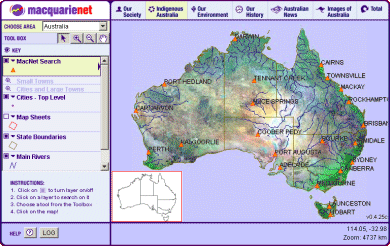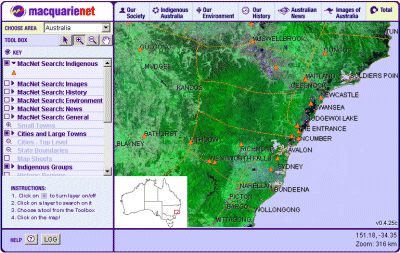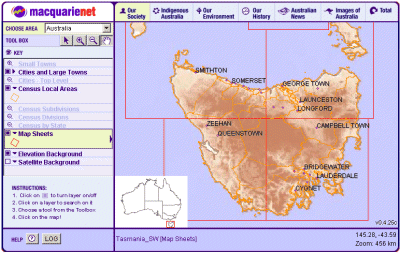
Figure 10a: MacNet Indigenous Australia theme. Orange triangles link to MacNet search result sets
The MacquarieNet application of TMJava represents a completely different use of the TimeMap methodology which emphasizes the potential use of web mapping for spatial indexing of extensive databases (Kraak 2001a, 1) and linking to rich, database-generated information pages.
MacquarieNet is a substantial online information resource for Australian material, giving subscription-based access to data which ranges from the site listings of the Australian Heritage Commission through standard encyclopaedia and dictionary listings to daily newsfeeds from Australian Associated Press. It has recently (March 2002) been redesigned to serve its primary audience better, the secondary education sector. Some Australian states have taken out subscriptions which make it freely available to all schools in the state.
MacquarieNet is intended as a rich, general-purpose reference resource rather than a targeted presentation. Consequently, the MacquarieNet application of TimeMap has no pre-determined pathways through the data, other than a choice between alternative themes (Environment, Indigenous Australians, Historical, Census, Images and News). An example of the TMJava applet is shown in Figure 10 (unfortunately there is no direct link to MacquarieNet interactive maps as it is a password only subscription service).

Figure 10a: MacNet Indigenous Australia theme. Orange triangles link to
MacNet search result sets

Figure 10b: TMJava applet zoomed in to display increased more localised
search results

Figure 10c: TMJava applet showing digital elevation model background and key to
topographic maps
"The challenge is to handle this richness of data over a modem connection"
The main challenge in this application is not the variety of data formats or the handling of time, but the volume of data involved. MacquarieNet contains tens of thousands of references which we could represent as points on the map, but clearly this is not a useful strategy. The background map data is also dense, including a 640Mbyte (uncompressed) satellite composite of Australia, a digital elevation model, census district polygons, roads, rivers and detailed background maps for capital cities. The challenge is to handle this richness of data over a modem connection. To do this we have implemented a number of strategies in TMJava for limiting the amount of data downloaded.
First, layers can be disabled outside a specified range of map scales. Highly detailed layers such as the lowest level census polygons are only made available when zoomed in, so that only a small number of polygons need to be downloaded at any time (layers which are outside the scale range over which they are displayed are indicated by plus and minus magnifying glass icons in the legend, a technique pioneered in TMView).
Secondly, datasets are served incrementally, so that only the raster image or map objects within the current viewer area are requested, and the appropriate subset is created by a server-side query of the data. This is particularly effective for very large and detailed datasets, provided they are enabled only when zoomed in, since the size of the complete dataset does not influence download size.
Thirdly, layers are requested at an appropriate resolution for the map displayed. This is fairly straightforward for layers served from an incremental image server such as MrSID, but we have also developed strategies to handle several levels of vector generalisation and to display the appropriate level as the map is zoomed in.
The MacquarieNet mapping application has not yet gone live, so to date we do not have feedback on the reactions to the map interface or issues with its use in the secondary education environment at which it is targeted.
Last updated: Wed Sep 11 2002
© Author(s). Content published prior to 2013 is not covered by CC-BY licence and requests for reproduction should usually go to the copyright holder (in most cases, the author(s)). For citation / fair-dealing purposes, please attribute the author(s), the title of the work, the Internet Archaeology journal and the relevant URL/DOI.